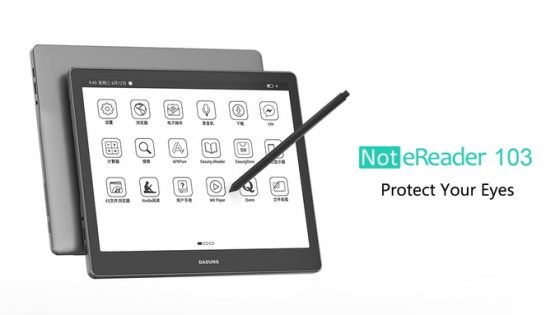Dasung is planning to release another Not-eReader device (which ironically is an ereader), this time with a 10.3-inch E Ink screen.
It looks cool and the specs are impressive on paper, and like other Dasung products it doubles as an E Ink monitor, but the price is pretty ridiculous, and Dasung is making claims that aren’t backed by science.
The Not-eReader 103 just showed up on Kickstarter, a crowd-funding website, with orders expected to ship in November 2020.
Dasung is asking a whopping $768 plus shipping for the version without a Wacom touchscreen and $838 plus shipping for the stylus-equipped model.
The Not-eReader 103 has a 10.3-inch E Ink screen with a dual-colored frontlight and an optional Wacom touchscreen. It has a Snapdragon 660 processor, 4GB of RAM, 64GB of storage space, plus a memory card slot. It supports dual band Wi-Fi, Bluetooth 5.0, and it has a massive 6400mAh battery. It runs Android 9.0 and is open to install apps, but it doesn’t support Google Play.
To put the price in perspective, the device is very similar to the Onyx Note2, which most people consider expensive at $549 (it’s currently on sale for $519), and Onyx has better software and they have a history of making decent ereaders for several years.
This is the second crowd-funding campaign that Dasung has run for their Not-eReader devices. Their first 7.8-inch Not-eReader was available via Indiegogo in 2018.
Their main selling point for the Not-eReader 103 is it’s safer for your eyes than LCD screens. They’re going with the fear-based approach to sell products, one that’s not even backed by science. Here’s a direct quote from the very first paragraph on the product page:
“The strong light stimulation, blue light, and strobing of the traditional LCD light-emitting screens can easily make our eyes fatigued even causing lesions that lead to irreversible damage.”
That is a totally bogus claim. There is no scientific evidence that LCD screens cause any kind of permanent eye damage (don’t take it from me, just ask your eye doctor).
Before you consider dropping over $800 on this device (seriously, how do they have any backers?) you might want to read through the comments at Indiegogo for their 7.8-inch Not-eReader. It sounds like there are numerous ongoing software problems and there are multiple complaints by people saying they never received a device after paying, and some have been waiting over a year. That’s probably why Dasung chose to use a different crowd-funding website this time around…


they only offered 20 devices with Wacom-Layer
No, it is not very similar to the Onyx Note2. It has a refresh rate that is so fast that you can browse the web and do research and typing as quickly as any computer would have done. The main advantage of such a device is to reduce eye strain caused by a computer. Onyx has no such quality because the time lag of its gadgets is very apparent. Therefore, Dasung is the best alternative so far. And writing such an article on something so beneficial for dry eye sufferers and so innovative refers to your dishonesty. Please, first check the device and write a critique afterward.
Have you even used an Onyx device? They offer several refresh settings to make the refresh rate faster. They can even play videos relatively smoothly. And you’re talking to someone that suffers from dry eye problems, and it makes no difference if I’m using LCD screens or E Ink screens, so I fail to see your point. There’s no proof that E Ink is better for dry eyes. If it works for you, that’s great, but not everyone is the same. If anything the light from LCD stimulates my eyes to water more.
I have not used onyx so far, but I’ve seen lots of their videos on youtube. Their refresh rate is slow compared to the new e-reader 103. Dasung device is similar to any LCD tablet in terms of refresh rate, while onyx is quite far from that. It is very tiresome to switch refresh rates all the time. Your tablet shall satisfy your research and typing needs at a minimum. As for the eye strain, see that link from a reliable source: https://www.ncbi.nlm.nih.gov/pmc/articles/PMC3873942/. It says that LCD screens cause more eye fatigue compared with e-ink. LCD reduces the eye-blinking rate causing dry eyes, while e-ink is almost similar to paper. Eyewatering is the first phase of dry eyes, and you are in danger of having a severe dry eye disease. Please find that link: https://www.youtube.com/watch?v=4P2JvyTq_10
Interesting study. Too bad they didn’t do any more follow-up tests. It seems the backlight brightness setting and duration of reading has the biggest impact on eye strain, which could probably be greatly minimized with frequent breaks and lower brightness settings. E Ink should be doing these kinds of tests if they want to keep claiming that E Ink screens are safer for our eyes. The unbacked claims is what really irritates me. Luckily my eyes have been doing better since I stopped using eye drops at night—somehow they were making things worse instead of better.